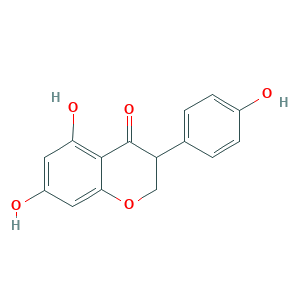Details of the Drug Metabolized by Drug-Metabolizing Enzyme (DME)
| General Information of Drug (ID: DR2668) | ||||||
|---|---|---|---|---|---|---|
| Drug Name |
Dihydrogenistein
|
|||||
| Synonyms |
Dihydrogenistein; 4',5,7-Trihydroxyisoflavan-4-one; 4',5,7-trihydroxyisoflavanone; CHEBI:34707; 5,7-Dihydroxy-3-(4-hydroxyphenyl)chroman-4-one; 5,7-Dihydroxy-3-(4-hydroxyphenyl)-2,3-dihydro-4H-chromen-4-one; C14458; Oprea1_192406; SCHEMBL678189; CHEMBL209856; 5,7,4'-trihydroxyisoflavanone; 4',5,7-trihydroxy-Isoflavanone; DTXSID80904153; UQGVUYNHDKMLSE-UHFFFAOYSA-N; SC-78730; FT-0696047; Q27116235; 21554-71-2
|
|||||
| Indication | Discovery agent | Investigative | [1] | |||
| Structure |
 |
|||||
| 3D MOL | 2D MOL | |||||
| Pharmaceutical Properties | Molecular Weight | 272.25 | Topological Polar Surface Area | 87 | ||
| Heavy Atom Count | 20 | Rotatable Bond Count | 1 | |||
| Hydrogen Bond Donor Count | 3 | Hydrogen Bond Acceptor Count | 5 | |||
| Cross-matching ID | ||||||
| The Metabolic Roadmap of This Drug | |||||
|---|---|---|---|---|---|
| The Full List of Drug Metabolites (DM) of This Drug | ||||||||||||||||||||||||||||||||||
|---|---|---|---|---|---|---|---|---|---|---|---|---|---|---|---|---|---|---|---|---|---|---|---|---|---|---|---|---|---|---|---|---|---|---|
|
||||||||||||||||||||||||||||||||||
| The Full List of Metabolic Reaction (MR) of This Drug | ||||||||||||||||||||||||||||||||||
|---|---|---|---|---|---|---|---|---|---|---|---|---|---|---|---|---|---|---|---|---|---|---|---|---|---|---|---|---|---|---|---|---|---|---|
|
||||||||||||||||||||||||||||||||||
| Drug-Metabolizing Enzyme(s) (DME) Metabolizing This Drug | ||||||||||||||||||||||||||||||||||
|---|---|---|---|---|---|---|---|---|---|---|---|---|---|---|---|---|---|---|---|---|---|---|---|---|---|---|---|---|---|---|---|---|---|---|
|
||||||||||||||||||||||||||||||||||
If you find any error in data or bug in web service, please kindly report it to Dr. Yin and Dr. Li.

